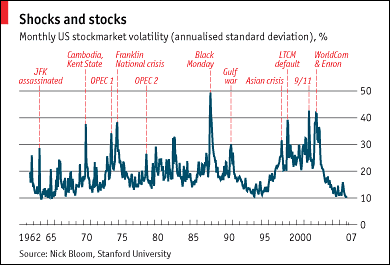The Shock of Uncertainty
Nick Bloom, an economist at the London School of Economics and Stanford, has done some fascinating research modelling the effects of uncertainty shocks on the investment decisions of firms and other macroeconomic actors. The gist of his research is that -- rather than focusing on the effects of macroeconomic shocks on the expected value (i.e., the first statistical moment of a probability distribution) of macroeconomic variables -- Prof. Bloom focuses on estimating the effects that volatility (i.e., the second moment of a probability distribution) shocks may have on firm level decisions in the macroeconomy.
Using numerical simulations with MATLAB (a computational mathematics software package), Dr. Bloom makes some interesting conclusions regarding what uncertainty shocks (i.e., second moment shocks) can do to economic decisionmaking. One of the many conclusions of the research is to confirm Ben Bernake's (formerly, a Princeton economist, but now the head of the Federal Reserve) previous research concluding that there is a 'real option' for firms to wait-and-see before making major decisions (such as making capital or labor investments). Another interesting conclusion is that second moment shocks tend (with the exception of the Great Depression period) to be transitory -- spikes in volatility lasts for a few months before settling back down.

Perhaps the most interesting finding by Prof. Bloom is that his model seems to fit well with what happened during the period on and following the 9-11 terrorist attack: a sharp spike in stock market volatility, many businesses taking a holding pattern before making major investment decisions, and, eventually, a return to relative normalcy (although it should be noted that the scandals involving Enron and Worldcom added further spikes in volatility that had a sort of knock-on effect that made the transition back to a lower volatility environment more uncomfortable than it otherwise could have been).
There are other findings that should be of interest to readers of this blog. You can download Nick Bloom's paper, The Impact of Uncertainty Shocks: Firm Level Estimation and a 9/11 Simulation, by clicking the link. A layman's overview of the research can be found in the Economics Focus section (Feb. 1, 2007) of The Economist: Momentous modelling: When terrorists strike, what happens to investment and jobs?
Using numerical simulations with MATLAB (a computational mathematics software package), Dr. Bloom makes some interesting conclusions regarding what uncertainty shocks (i.e., second moment shocks) can do to economic decisionmaking. One of the many conclusions of the research is to confirm Ben Bernake's (formerly, a Princeton economist, but now the head of the Federal Reserve) previous research concluding that there is a 'real option' for firms to wait-and-see before making major decisions (such as making capital or labor investments). Another interesting conclusion is that second moment shocks tend (with the exception of the Great Depression period) to be transitory -- spikes in volatility lasts for a few months before settling back down.

Perhaps the most interesting finding by Prof. Bloom is that his model seems to fit well with what happened during the period on and following the 9-11 terrorist attack: a sharp spike in stock market volatility, many businesses taking a holding pattern before making major investment decisions, and, eventually, a return to relative normalcy (although it should be noted that the scandals involving Enron and Worldcom added further spikes in volatility that had a sort of knock-on effect that made the transition back to a lower volatility environment more uncomfortable than it otherwise could have been).
There are other findings that should be of interest to readers of this blog. You can download Nick Bloom's paper, The Impact of Uncertainty Shocks: Firm Level Estimation and a 9/11 Simulation, by clicking the link. A layman's overview of the research can be found in the Economics Focus section (Feb. 1, 2007) of The Economist: Momentous modelling: When terrorists strike, what happens to investment and jobs?


0 Comments:
Post a Comment
<< Home